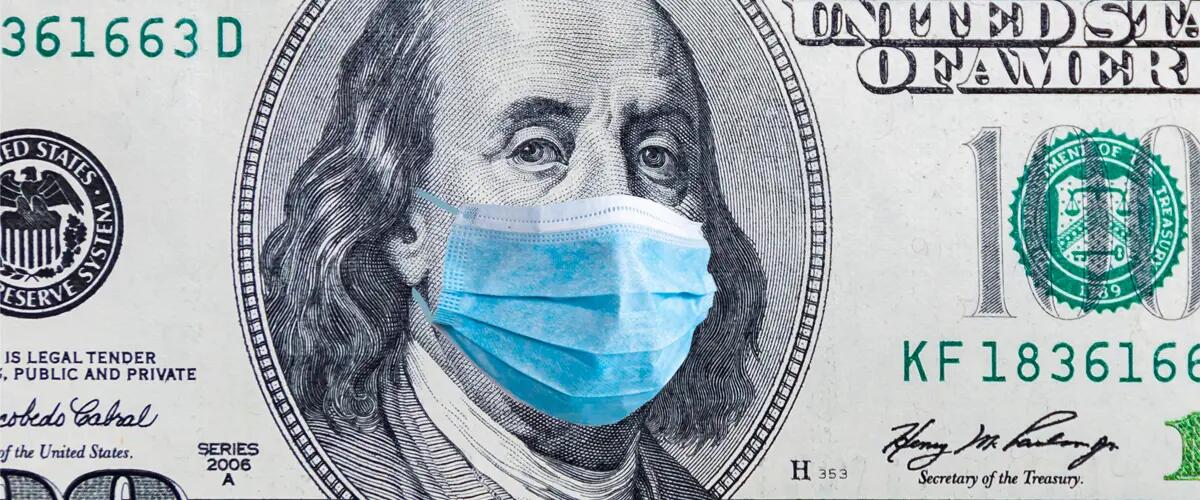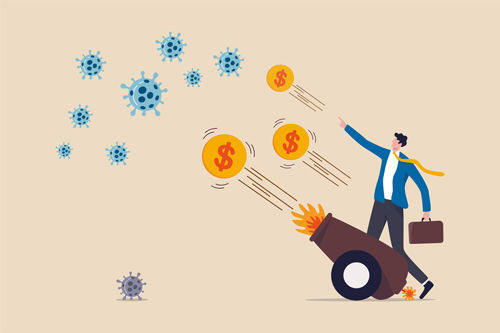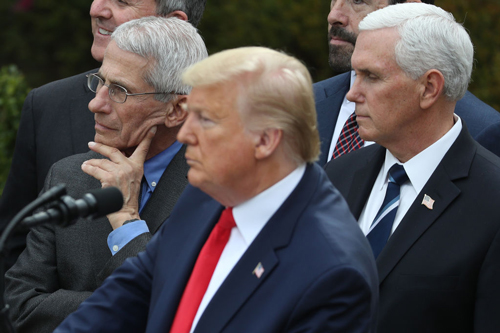
Modern Monetary Theory and Covidonomics: How This Will End
By Farrokh Langdana, Director, Executive MBA Program & Professor of Finance and Economics
All views expressed here are those of Prof. Farrokh Langdana’s and not those of the Rutgers Executive MBA Program or Rutgers Business School. Many of the questions are actual emails from students and alumni.
For more of Prof. Langdana’s blogs please visit his Faculty Blog: business.rutgers.edu/Langdanamacro.
The Federal Reserve cut interest rates 0.5% to 1.25% (3/3/20) in an emergency effort to contain the economic impact of the coronavirus (COVID-19), the biggest one-time cut since the financial crisis in 2008.
A sustainable Federal budget deficit used to be defined as being less than about 5% of GDP.[1] Today the Budget deficit/GDP is over 13%! Disaster, right? Should we expect hyperinflation to be coming?
Short answer: No. Keep in mind we were in that ballpark during the subprime crisis (10-12% for the budget deficit/GDP ratio) and the sky did not fall on our heads.
Yes, but why? With such large deficits, there should be massive printing of money and then the resulting hyperinflation, right? Isn’t this when the ratio generally shoots over 5%?
Back in the day, yes. But in the subprime mortgage crisis we had a unique situation. The U.S. was still the “safest cave” on the planet.[2] With all global economies “huddling in their caves” in the global housing crisis, we had the “best cave” and, consequently, massive global capital poured in and, to some extent, helped fund our budget deficit.
Was this inflow of foreign capital enough to get us through the subprime crisis?
Not hardly. We also printed grotesque amounts of money, known as Quantitative Easing (QE) which has been discussed in my other blogs in detail[3]. In fact, initially the Fed injected $48 billion per month, and later, $24 billion a month from 2007-15!
Still no inflation?
No. And here is a very important point. Massive monetary infusions ONLY erupt into mind numbing hyperinflations when the money is actually injected into the economy. If it just “sits there” within lending institutions, then…..no inflation! For example, the 5,500% inflation rate in the case of the Weimar Republic (Germany post-WW1), and the 41.9 x 1015 % rate for the last month of the Hungarian Hyperinflation (1946), were due to the fact that the money that was printed was already thrown into circulation – they were finally paying teachers, troops, farmers, suppliers, government workers, etc., who had not been paid for months.[4] The money was rapidly injected into the economy; in fact it was “already spent.” Ditto for Zimbabwe, Argentina, Brazil, Venezuela, and others.
These numbers are staggering! How is this possible?
It is like a snake bite. The venom (for most snake bites) is only lethal if it goes directly into the blood stream (or soft tissue). If it does not, you live. (Please do not test this example, I am not a global expert on venoms, but you get the point.) Same with monetary creation and hyperinflation. If the massive infusion of money does not slip into the economy, then no hyperinflation.
So today…..the > 13% ratio, and the HUGE Federal infusion of money of over $3 trillion so far, going to maybe $8-10 trillion or more…..no worries?
Same story, larger numbers. But this time we have a name for it: Modern Monetary Theory (MMT).

Modern? So is this new?
No. There is nothing modern about it and it is not even a “theory!” Basically it’s like this. In the subprime crisis, the massive printing of money did not bring about hyperinflation, as explained above. So Alexandria Ocasio Cortez (AOC) and Bernie Sanders ran with this MMT theory. Their reasoning: Just print money! Print it for green jobs and for free college tuition. According to them: We printed money like crazy, last time, to bail out all the institutions that were “stuck” holding the rotten mortgage-backed securities, and the sky did not fall on our heads. The role of money should be simply to ‘get printed’ and pay for the massive government spending. So, doing this is not a problem. Print away!
What about the accepted ratio of 5%?
Gone. In a world where the U.S. is the “safest cave” and where there are NO other alternatives for scared global capital to be “parked” until the storms wear off, we can pull this off. There is no “ratio.” The upper limit? Gone!
What is the risk?
Plenty! I call this kind of monetization, “Circumstantial Macroeconomics.” Just because it worked last time, we are assuming that we can pull it off every time. It is like this: some guy rakes all his Fall leaves and stacks them in his back yard right by his neighbor’s fence. Then this genius lights a fire to burn off the dry leaves. Very dangerous! The neighbor is holding her breath, one hand on her phone, the other holding her water hose. But the wind is in the “right” direction, and the flames do not hurt her house. Now, lo and behold, this guy then tries this again every year, hoping that the wind will always blow in the “right” direction! “Circumstantial” behavior indeed!
If the rest of the world’s economies perk up (other “caves” become safer) and/or if confidence levels spike here and we start borrowing and investing all the money that has been created, then will we get slammed by inflation? In your words, the wind could change direction?
Yes, if—IF—this were to happen, perversely, something that seems “good” would cause the specter of inflation to rise dramatically here.
With no downside to the massive infusion of money in the subprime crisis, nor today in the covid crisis? Shouldn’t the low interest rates caused by this massive infusion help capital investment?
One “downside” last time, was the run-up in the stock market. The rally in equities was significantly fueled by the massive creation of liquidity. And beware stock market run-ups driven by liquidity creation – they rise well and collapse well too! In fact, they collapse in spectacular fashion as we saw in March 2020. I expect another future rally powered by this mega-monetization at present, after calm finally settles on the market. If you decide to ride it, you do so at your own peril. Regarding low interest rates supposedly spurring growth in capital investment – there is not much evidence of that recently. It is called a ‘Liquidity Trap” (see video). If investor confidence is low, due to global trade war, global conflicts, internal politics, over-regulation, high taxes, Presidential shenanigans, and so on, then low interest rates will be ineffective. Hence the rallying cry from the Modern Monetary Theory people that “The Fed has lost its Mojo!”
Speaking of the stock market, can you explain the collapse in March 2020? The economy was in much better shape this time relative to 2007. The banks are so much better capitalized. What happened?
Very important point here. You must understand, Bad Macro Trumps Good Finance!
Bad Macro is like a giant tsunami (are there any non-giant tsunamis)? It is a panic-driven monster that is irresistible and relentless. Typically, investment choices in the stock market may be 70% based on solid theory-hardened numbers, and 30% driven by behavioral (emotional) finance, as in “my family, for generations, only drives Fords so I must have Ford in my stock portfolio.” But in times of great fear and panic, it becomes all emotional-driven. The Macro tsunami washes away all seashore towns, the good ones (good companies) as well as the bad ones (weak companies). There is nothing one can do but wait for the flood waters to subside. Only then, in the soggy, muddy debris in the wake of the tsunami will one find that companies who were strong before, will typically survive. All those who were weak and at a “comparative disadvantage” (the “anchor stores” in big malls) will quietly drown in the tsunami.[5] Bad Macro Trumps Good Finance. A good diagram explaining the life-cycle of a speculative asset-price bubble is the Kindelberger-Minsky explanation.[6]

Coming back to the Fed creating money hand-over-fist. Isn’t the currency tied to gold? Are there no macroeconomic restraints on how much a “rogue” central bank can print?
None. Not since August 15, 1971 when President Nixon took us off the Gold Standard.[7] In fact, following this move that many viewed as calamitous, we actually had a very impressive record of maintaining our money growth as if we had some implicit standard for monetary rectitude. All that was backing the US dollar was the strength and reliability and macroeconomic discipline of our institutions—no gold, nothing else. And Fed Chairmen Paul Volcker and then later, Chairman Alan Greenspan, embodied this discipline. I call this the Golden Age of the Fed, when even without a gold “anchor” we ensured that an unbacked (“fiat”) currency was still the benchmark for the planet and still a paragon of monetary discipline. But alas, all that went down the drain in the subprime crisis, discussed at length in other blogs, and cited above.
You mentioned earlier you expected “market calm to settle.” What is the chance of another Great Depression before that? The unemployment rate and the fall in GDP are already in the 1930s ballpark.
Keep in mind, the Great Depression and many of the recent recessions including the Great Recession (the subprime crisis of 2007-2010) were caused by endemic and internal failures from within the economy.[8]! Typically, bubbles burst (stock market, housing, dotcoms), or soft landings became hard landings. This time, in 2020, however, the economic collapse was caused by an exogenous supply shock; it came from outside the economy. We actually had to switch off our economy and shut down human activity to give our hospitals and healthcare institutions a chance to combat the virus. With household consumption comprising a whopping 73% of the economy, it is no wonder that the economy screeched to a halt. So, BIG difference there!
Any other differences?
Yes. The Fed did not provide liquidity in the Great Depression. In fact, Milton Friedman (perhaps, Rutgers’ greatest product) and Anna Schwartz cite this reason in their Monetary History of the United States, as perhaps the critical factor that collapsed the economy in the 1930s. According to them, the Fed’s reluctance to provide liquidity resulted in effective money supply contracting by almost 33%! The Fed today has been at the diametrically opposite end of this spectrum with its $3+ trillion infusion to date, expected to be up to $10 trillion by the time this is over.
What about the Fed having “lost its mojo?”
When it comes to jump-starting the economy in an environment of very low confidence (liquidity trap), yes, the Fed influence is gone for now. Gone are the days of Greenspan when the planet hung on to any utterances from the Fed that might signal future rate changes. That whole drama is gone. Fed rate changes today are largely non-events. But when you look at the Covid-rescue, only the Fed has been seen in action – and how! This time the Fed has even re-activated Section 13(3) where it can rapidly provide financial assistance directly to beleaguered companies in crisis![9] The massive monetary infusion is designed to keep “oil in the engine” and to prevent the economy from seizing up. That, very simply, is the goal. Behold, Covidonomics! The other two levers, government spending and tax cuts, are missing in action. If and when they do “arrive” at the scene, it will be months into the future.
Speaking of the future…do you see a V-shaped recovery? U-shaped? Will it be accompanied by deflation? There seem to be deflation fears.
I really don’t want to get bogged down in the “shape” of the recovery, but given the high pent-up demand in so many sectors, I see a V recovery, but the “leg” of the recovery will be shorter as attrition mounts. I also see a positive total factor productivity shock[10]. As employers realize that they now can do as well, if not better, with fewer workers and fewer units of capital, we will see permanent attrition in jobs and fixed assets (parking decks, downtown offices). This positive productivity shock will prove disinflationary. Keep in mind “disinflation” is not to be confused with “deflation.” Disinflation could be, for example, inflation dropping from 1.5% to 1.3%, while deflation (again, as an example) would be inflation falling from, say, 1.5% to -0.89%. The latter is by far the greater evil; deflation causes consumers to postpone purchases of big-ticket items, and the positive real interest rates encourage saving at the expense of consumption[11]. Again, with household consumption being 73% of our economy, deflation is a killer.
How similar is the Covid Crisis with the Great Depression?
The Fed response has been diametrically different from that of the Great Depression as discussed earlier. The Fed rushes in now to pump liquidity into the market, in sharp contrast to the 1930s. The one glaring similarity is the Trump-induced Trade War. There was a big trade war in the 1930s, sparked by the Smoot-Hawley Tariffs which were slapped onto imports by the U.S. Today, we have the Trump Trade war, which is now sadly deteriorating into an even more acrimonious relationship with China.
“Sadly”? Why the lament?
Well, it does not have to be this way. A rising tide can raise all ships. And do not forget, 65% of all the money China has made since Deng Xiaoping threw open China’s doors to the world in 1979 are parked in US dollars! China and America are inextricably married by the US dollar. This is all not about only trade, it is even more critically about capital linkages. Most analysts seem to ignore this all important capital connection.
How will this end?
There will be a vaccine, but that will not be the end all; a vaccine will not be a panacea. There will be other exogenous macroeconomic shocks. We need to cure our internal fractures first. As Lincoln said, “A House Divided Cannot Stand.” We need a real leader; a Unifier, and not a Divider. Look at President John F. Kennedy. His framed photo still hangs today in so many homes all over the world. In fact, one of my earliest memories from Mumbai, India, is of my mom weeping on November 22, 1963. She was a tough-as-nails doctor; she never cried. So this was profoundly different. Upon asking her she told me of JFK’s assassination. A global unifier was he. Right now, first and foremost, we have a leadership Issue. A House Divided Cannot Stand.
Footnotes:
Links to Google Books where you can search inside for specific footnote references:
Macroeconomic Policy: Demystifying Monetary and Fiscal Policy
International Trade and Global Macropolicy Policy
[1] Please see Macroeconomic Policy: Demystifying Monetary and Fiscal Policy, Springer Press, Edition 3, Farrokh Langdana, page 35, for a description of the Dornbusch Model of Sustainability.
[2] Please visit my blog page (including videos) for several blogs on this subject. https://www.business.rutgers.edu/faculty/farrokh-langdana and then scroll down for the blogs.
[3] Please visit the Langdana faculty profile page and then scroll down for the blogs.
[4] The German rate is the annualized inflation rate, while that for Hungary is the rate JUST for the very last month of the hyperinflation (August, 1946)! Please see pages 134-48 of Macroeconomic Policy: Demystifying Monetary and Fiscal Policy, by Farrokh Langdana, Springer Press, Edition 3, for lots on this subject.
[5] For an explanation of Comparative Advantage, please see, International Trade and Global Macropolicy, Springer Press, Farrokh Langdana and Peter Murphy, pages 10-18.
[6] Kindelberger-Minsky is really not covered in class in the Executive MBA or the MBA programs at Rutgers Business School. It is very controversial, given the absence of any theoretical underpinnings. However, this is precisely why it is valuable at a time such as 2020, when all theory and all underpinnings were washed aside in a tidal wave of panic and hysteria. If nothing else, it is a very interesting and thought-provoking life-cycle of a bubble.
[7] Please see, International Trade and Global Macropolicy Policy, Springer Press, Farrokh Langdana and Peter Murphy, pages 382-94, for a history and discussion of the demise of the Gold Standard.
[8] Please see chapter 9, Macroeconomic Policy: Demystifying Monetary and Fiscal Policy, Edition 3, Farrokh Langdana, pages 220-25 for the four macropolicy mistakes that led to the Great Depression.
[9] Section 13(3) was developed in the subprime crisis and came under some controversy as it was thought that the Fed was picking and choosing which companies/individuals/partnerships to “save” and which to not. This time (2020) the Treasury is supposed to have “oversight” of Section 13 (3) operations by the Fed to ensure that there is no alleged Fed “bias” in its rescue operations.
[10] See chapter 10, Macroeconomic Policy, by Langdana.
[11] From the Fisher Effect, r = i – (expected inflation), where I = nominal interest rate. If expected inflation is < 0, then real rates r are > 0.
Press: For all media inquiries see our Media Kit


